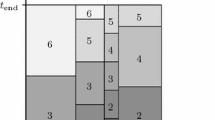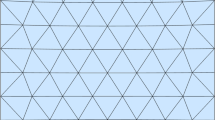Abstract
In this paper, we propose a class of adaptive multiresolution (also called adaptive sparse grid) discontinuous Galerkin (DG) methods for simulating scalar wave equations in second order form in space. The two key ingredients of the schemes include an interior penalty DG formulation in the adaptive function space and two classes of multiwavelets for achieving multiresolution. In particular, the orthonormal Alpert’s multiwavelets are used to express the DG solution in terms of a hierarchical structure, and the interpolatory multiwavelets are further introduced to enhance computational efficiency in the presence of variable wave speed or nonlinear source. Some theoretical results on stability and accuracy of the proposed method are presented. Benchmark numerical tests in 2D and 3D are provided to validate the performance of the method.





Similar content being viewed by others
References
Ainsworth, M., Monk, P., Muniz, W.: Dispersive and dissipative properties of discontinuous Galerkin finite element methods for the second-order wave equation. J. Sci. Comput. 27(1–3), 5–40 (2006)
Alpert, B.: A class of bases in \(L^2\) for the sparse representation of integral operators. SIAM J. Math. Anal. 24(1), 246–262 (1993)
Appelö, D., Hagstrom, T.: A new discontinuous Galerkin formulation for wave equations in second-order form. SIAM J. Numer. Anal. 53(6), 2705–2726 (2015)
Arnold, D.N.: An interior penalty finite element method with discontinuous elements. SIAM J. Numer. Anal. 19(4), 742–760 (1982)
Arnold, D.N., Brezzi, F., Cockburn, B., Marini, L.D.: Unified analysis of discontinuous Galerkin methods for elliptic problems. SIAM J. Numer. Anal. 39(5), 1749–1779 (2002)
Berger, M.J., Colella, P.: Local adaptive mesh refinement for shock hydrodynamics. J. Comput. Phys. 82(1), 64–84 (1989)
Berger, M.J., Oliger, J.: Adaptive mesh refinement for hyperbolic partial differential equations. J. Comput. Phys. 53(3), 484–512 (1984)
Bokanowski, O., Garcke, J., Griebel, M., Klompmaker, I.: An adaptive sparse grid semi-Lagrangian scheme for first order Hamilton-Jacobi Bellman equations. J. Sci. Comput. 55(3), 575–605 (2013)
Brown, D.L., Chesshire, G.S., Henshaw, W.D., Quinlan, D.J.: Overture: an object-oriented software system for solving partial differential equations in serial and parallel environments. Technical report, Los Alamos National Lab., NM (United States) (1997)
Bungartz, H.-J., Griebel, M.: Sparse grids. Acta Numerica 13, 147–269 (2004)
Burstedde, C., Wilcox, L.C., Ghattas, O.: p4est: scalable algorithms for parallel adaptive mesh refinement on forests of octrees. SIAM J. Sci. Comput. 33(3), 1103–1133 (2011)
Calle, J.L.D., Devloo, P.R.B., Gomes, S.M.: Wavelets and adaptive grids for the discontinuous Galerkin method. Numer. Algorithms 39(1–3), 143–154 (2005)
Chou, C.-S., Shu, C.-W., Xing, Y.: Optimal energy conserving local discontinuous Galerkin methods for second-order wave equation in heterogeneous media. J. Comput. Phys. 272, 88–107 (2014)
Cockburn, B., Hou, S., Shu, C.-W.: The Runge-Kutta local projection discontinuous Galerkin finite element method for conservation laws. IV. The multidimensional case. Math. Comput. 54(190), 545–581 (1990)
Cockburn, B., Karniadakis, G., Shu, C.-W.: The development of discontinuous Galerkin methods. In: Cockburn, B., Karniadakis, G., Shu, C.-W. (eds.) Discontinuous Galerkin Methods: Theory, Computation and Applications, vol. 11, pp. 3–50. Springer, Berlin (2000)
Cohen, G.C.: Higher-Order Numerical Methods for Transient Wave Equations. Springer, Berlin (2002)
Etienne, V., Chaljub, E., Virieux, J., Glinsky, N.: An hp-adaptive discontinuous Galerkin finite-element method for 3-d elastic wave modelling. Geophys. J. Int. 183(2), 941–962 (2010)
Gottlieb, D., Orszag, S.A.: Numerical Analysis Of Spectral Methods: Theory and Applications. SIAM, Philadelphia (1977)
Gottlieb, S., Shu, C.-W., Tadmor, E.: Strong stability preserving high order time discretization methods. SIAM Rev. 43, 89–112 (2001)
Grote, M.J., Schneebeli, A., Schötzau, D.: Discontinuous Galerkin finite element method for the wave equation. SIAM J. Numer. Anal. 44(6), 2408–2431 (2006)
Guo, W., Cheng, Y.: A sparse grid discontinuous Galerkin method for high-dimensional transport equations and its application to kinetic simulations. SIAM J. Sci. Comput. 38(6), A3381–A3409 (2016)
Guo, W., Cheng, Y.: An adaptive multiresolution discontinuous Galerkin method for time-dependent transport equations in multidimensions. SIAM J. Sci. Comput. 39(6), A2962–A2992 (2017)
Gustafsson, B., Kreiss, H.-O., Oliger, J.: Time Dependent Problems and Difference Methods, vol. 24. Wiley, Hoboken (1995)
Henshaw, W.D.: A high-order accurate parallel solver for Maxwell’s equations on overlapping grids. SIAM J. Sci. Comput. 28(5), 1730–1765 (2006)
Hesthaven, J., Warburton, T.: Nodal high-order methods on unstructured grids. I time-domain solution of Maxwell’s equations. J. Comput. Phys. 181, 186–221 (2002)
Hovhannisyan, N., Müller, S., Schäfer, R.: Adaptive multiresolution discontinuous Galerkin schemes for conservation laws. Math. Comput. 83(285), 113–151 (2014)
Huang, J., and Cheng, Y.: An adaptive multiresolution discontinuous Galerkin method with artificial viscosity for scalar hyperbolic conservation laws in multidimensions (2019). arXiv preprint arXiv:1906.00829
Huang, J., Shu, C.-W.: Error estimates to smooth solutions of semi-discrete discontinuous Galerkin methods with quadrature rules for scalar conservation laws. Numer. Methods Partial Differ. Equ. 33(2), 467–488 (2017)
Joly, P.: Variational Methods for Time-Dependent Wave Propagation Problems. Volume 31 of Topics in Computational Wave Propagation, pp. 201–264. Springer, Berlin (2003)
Käser, M., Dumbser, M.: An arbitrary high-order discontinuous Galerkin method for elastic waves on unstructured meshesi. the two-dimensional isotropic case with external source terms. Geophys. J. Int. 166(2), 855–877 (2006)
Mallat, S.: A Wavelet Tour of Signal Processing. Elsevier, Amsterdam (1999)
Reed, W., Hill, T.: Tiangular mesh methods for the neutron transport equation. Technical report, Los Alamos National Laboratory, Los Alamos, NM (1973)
Seriani, G., Priolo, E.: Spectral element method for acoustic wave simulation in heterogeneous media. Finite Elem. Anal. Des. 16(3–4), 337–348 (1994)
Shen, J., Yu, H.: Efficient spectral sparse grid methods and applications to high-dimensional elliptic problems. SIAM J. Sci. Comput. 32(6), 3228–3250 (2010)
Shu, C.-W., Osher, S.: Efficient implementation of essentially non-oscillatory shock-capturing schemes. J. Comput. Phys. 77(2), 439–471 (1988)
Sjögreen, B., Petersson, N.A.: A fourth order accurate finite difference scheme for the elastic wave equation in second order formulation. J. Sci. Comput. 52(1), 17–48 (2012)
Tao, Z., Jiang, Y., Cheng, Y.: An adaptive high-order piecewise polynomial based sparse grid collocation method with applications (2019). arXiv preprint arXiv:1912.03982
Tromp, J., Komatitsch, D., Liu, Q.: Spectral-element and adjoint methods in seismology. Commun. Comput. Phys. 3(1), 1–32 (2008)
Wang, Z., Tang, Q., Guo, W., Cheng, Y.: Sparse grid discontinuous Galerkin methods for high-dimensional elliptic equations. J. Comput. Phys. 314, 244–263 (2016)
Wilcox, L.C., Stadler, G., Burstedde, C., Ghattas, O.: A high-order discontinuous Galerkin method for wave propagation through coupled elastic-acoustic media. J. Comput. Phys. 229(24), 9373–9396 (2010)
Xing, Y., Chou, C.-S., Shu, C.-W.: Energy conserving local discontinuous Galerkin methods for wave propagation problems. Inverse Probl. Imaging 7(3), 967 (2013)
Zeiser, A.: Fast matrix-vector multiplication in the sparse-grid Galerkin method. J. Sci. Comput. 47(3), 328–346 (2011)
Acknowledgements
We would like to thank Daniel Appelö for discussions on numerical examples of wave propagation, Qi Tang and Kai Huang for the assistance and discussion in code implementation.
Author information
Authors and Affiliations
Corresponding author
Additional information
Publisher's Note
Springer Nature remains neutral with regard to jurisdictional claims in published maps and institutional affiliations.
Research supported in part by a grant from the Simons Foundation (426993, Yuan Liu). Research is supported by NSF Grant DMS-1830838, Research is supported by NSF Grants DMS-1453661 and DMS-1720023. Research is supported by NSFC Grant 12001231 (Zhanjing Tao).
Interpolation Basis Functions
Interpolation Basis Functions
For completeness of the paper, we present details of the multiresolution interpolation basis functions, which are first introduced in [37]. We will first focus on the case in which the interpolation points are imposed in the inner domain, as implemented in Table 5. Then we discuss the case in which the points includes the cell interface points. Here, we only discuss the case when \(M=4\) and \(M=5\). For \(M=1,2,3\), we refer readers to the appendix in [27].
The basis functions in \(\tilde{W}_1\) are piecewise polynomials on \(I_l:=(0,\frac{1}{2})\) and \(I_r:=(\frac{1}{2},1)\). Note that the functions may be discontinuous at the interface \(x=1/2\), thus \(I_l\) and \(I_r\) are both defined to be open intervals. The basis functions in \(\tilde{W}_1\) in this paper are all supported on one half interval \(I_l\) or \(I_r\) and vanish on the other half. For simplicity, we will only declare the function on its support. For example, \(\psi _0(x)|_{I_r}\) gives the definition of \(\psi _0\) on \(I_r\) and indicates that \(\psi _0\) vanishes on \(I_l\).
1.1 Interpolation Points in the Inner Domain
1.1.1 \(M=4\)
The interpolation points are
The basis functions in \(\tilde{W}_0^4\) and \(\tilde{W}_1^4\) are
and
1.1.2 \(M=5\)
The interpolation points are
The basis functions in \(\tilde{W}_0^5\) and \(\tilde{W}_1^5\) are
and
1.2 Interpolation Points with the Interface Points
1.2.1 \(M=4\)
The interpolation points are
The basis functions in \(\tilde{W}_0^4\) and \(\tilde{W}_1^4\) are
and
1.2.2 \(M=5\)
The interpolation points are
The basis functions in \(\tilde{W}_0^5\) and \(\tilde{W}_1^5\) are
and
Rights and permissions
About this article
Cite this article
Huang, J., Liu, Y., Guo, W. et al. An Adaptive Multiresolution Interior Penalty Discontinuous Galerkin Method for Wave Equations in Second Order Form. J Sci Comput 85, 13 (2020). https://doi.org/10.1007/s10915-020-01322-w
Received:
Revised:
Accepted:
Published:
DOI: https://doi.org/10.1007/s10915-020-01322-w




